Examples of writing
Monumental script: 8th cent. B.C. (Jawf)
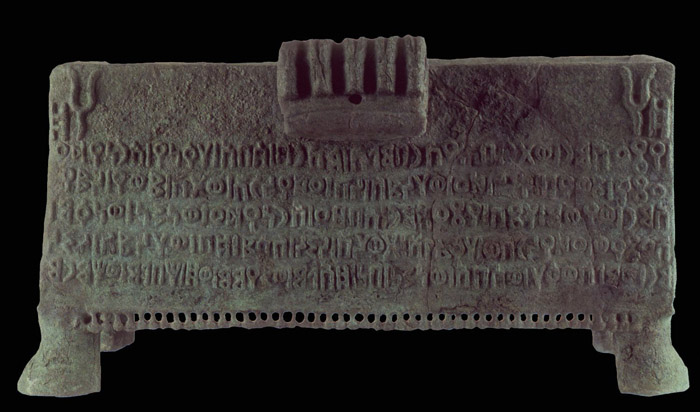
Source: Caubet, Annie and Gajda, Iwona 2003. Deux autels en bronze provenant de l'Arabie méridionale, suivi d'un appendice de Mme Françoise Demange sur la technique de fabrication (note d'information). Comptes Rendus de l'Académie des Inscriptions et Belles Lettres: 1219-1242.
AO 31929
1 Yṯʿʾmr Wtr bn Ykrbmlk mkrb S¹bʾ hqny ʾrnydʿ
2 [S²]ymn ywm ʾtw ʾrnydʿ bn Kmnhw ʿd N[s²](n)( b)-ywm Yṯʿ—
3 ʾmr w-ywm hṯb Yṯʿʾmr ʾbḍʿ ʾrnydʿ w-Ns²n w-nqm |
4 Ns²n Kmnhw b-ḏ ms¹k Ns²n ʾḫwt ʾlmqh w-ʾrnydʿ w-Yṯʿʾ—
5 mr w-Mlkwqh w-S¹bʾ w-Ns²n bn ḏ-ʾlm w-s²ymm w-ḏ ḥblm w-ḥmrm
1 Yathaʿʾamar Watar son of Yakrubmalik, mukarrib of Sabaʾ, dedicated to Aranyadaʿ,
2 the Patron, when he brought back (the statue of) Aranyadaʿ from Kamna to Nashshān, at the time of
3 Yathaʿʾamar, and when he assigned the territories to Aranyadaʿ and Nashshān and vindicated
4 Nashshān against Kamna, because Nashshān had maintained the alliance of Almaqah and Aranyadaʿ, and
5 Yathaʿʾamar and Malikwaqah, and Sabaʾ and Nashshān, on the basis of that (i.e. the alliance) of the god and the patron, and that of the territory and the population.
Royal inscription in early Sabaic language on a bronze altar from as-Sawdāʾ/Nashshān (last quarter of the 8th c. BC).
Pre-classical graphic style, with a proportion of 1/2 height to width of the characters; letters with right angles, large circles and m with two triangles.
Boustrophedon ductus.
Monumental script: 7th cent. B.C. (Sabaʾ)
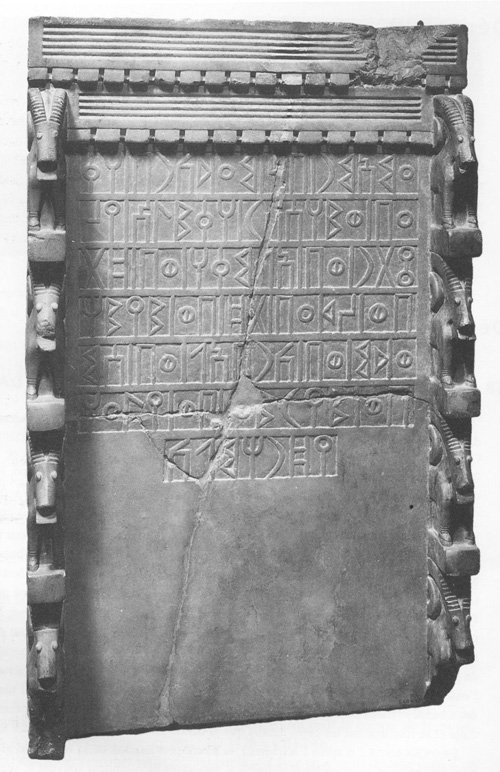
Source: Calvet, Yves and Robin, Christian J. 1997. Arabie heureuse. Arabie déserte. Les antiquités arabiques du Musée du Louvre. Avec la collaboration de Françoise Briquel-Chatonnet and Marielle Pic. Paris: Editions de la Réunion des musées nationaux: 139-141, cat. 68.
RES 4226
1 ʿmʾmr bn Mʿdkrb hq-
2 ny ʾlmqh Rʾs¹hmw b-ʿ-
3 ṯtr w-b ʾlmqh w-b
4 ḏt-Ḥmym w-b ḏt Bʿdn w-b-
5 Wdm w-b Krbʾl w-b S¹m-
6 hʿly w-b ʿmrym w-b
7 Yḏrḥmlk
1 ʿmʾmr, son of Mʿdkrb, dedicated
2 to Almaqah Rʾs¹hmw. By
3 ʿAthtar, Almaqah, dhat
4 Ḥimyam, dhat Baʿdan and
5 Waddum; and by Karibʾīl,
6 Sumhūʿalī and by ʿmrym and
7 Yḏrḥmlk.
Dedicatory inscription in early Sabaic language on an alabaster stela from Maʾrib (early 7th c. BC).
Classic graphic style, with a proportion of 1/3 height to width of the characters; letters with straight angles and m with two triangles.
Boustrophedon ductus.
Monumental script: 6th cent. B.C. (Sabaʾ)

Source: Müller, Walter W. 1982. Bemerkungen zu einigen von der Yemen-Expedition 1977 des Deutschen Archäologischen Instituts aufgenommenen Inschriften aus dem Raum Mārib und Barāqiš. Archäologische Berichte aus dem Yemen, 1: 129-134, pl.6/a.
CIH 622
1 Yṯʿʾmr Byn bn S¹mhʿly Ynf mkrb
2 S¹bʾ mḫḍ blq mʾḫḏn Ḥbbḍ mnḫy Ys¹rn
1 Yathaʿʾamar Bayān, son of Sumhūʿalī Yanūf, mukarrib
2 of Sabaʾ, broke the limestone of the dam Ḥabābiḍ towards Yasrān.
Royal construction inscription in early Sabaic language engraved on the sluice of the dam of Maʾrib.
“Classic” graphic style, with a proportion of 1/3 height to width of the characters; letters still with right angles but also with first hint of acute angles, small circles and thickness of the stroke; letter m with two triangles and spread points, and large r.
Monumental script: 4th-3rd cent. B.C. (Sabaʾ)
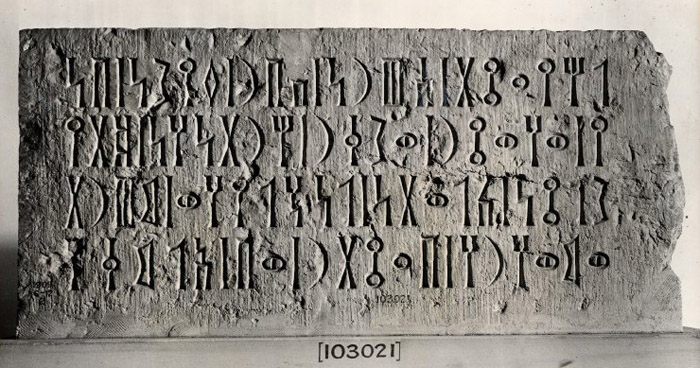
Source: Progetto DASI (Università di Pisa).
RES 3913
1 Lḥyʿṯt S¹ṭrn kbr Fys²n bn-
2 y w-hwṯr w-s²qr ḥrtnhn ḏty
3 s²lṯn klwtn l-nḫly-hw Mṭrt
4 w-Mwhrh b-ʿṯtr w-b ʾlmqh
1 Lḥyʿṯt S¹ṭrn, kabir of Fayshān, built,
2 and laid foundations and completed two canals, those of
3 the three dams for his two palm groves Mṭrt
4 and Mwhrh; by ʿAthtar and by Almaqah.
Construction inscription in early middle Sabaic language of unknown origin, and housed in the British Museum (London). The comparison with other documents of more certain dating sets the inscription at about the 4th – 3rd c. BC.
Graphic style with a proportion of 1/2 height to width of the characters; letters with acute angles and thick ends; “open” m, “raised” s² and elliptical w.
Monumental script: 1st c. B.C.-1st c. A.D. (Qatabān)
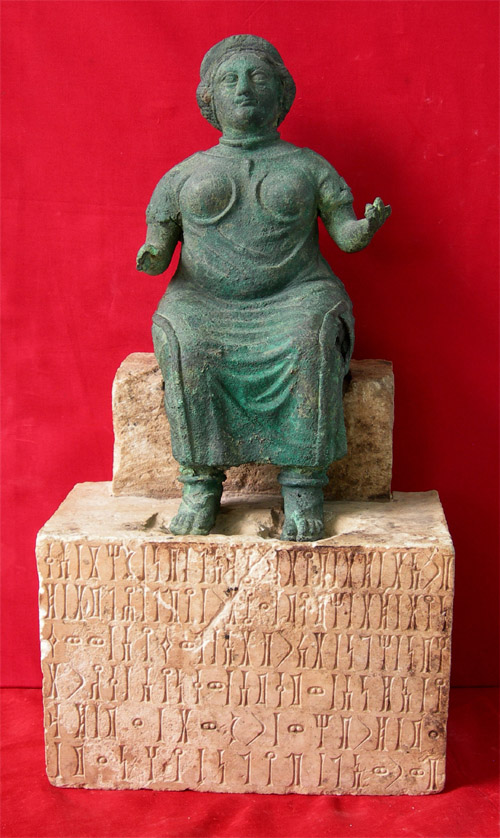
Source: Progetto CASIS (Università di Pisa).
CIAS 47.11/o 1/F 72
1 Brʾt ḏt byt Rṯdʾl bn S²ḥz s¹q—
2 nyt ḏt Ḥmym ʿṯtr Yġl ṣlmt ḏ—
3 hbn ḥg-n tkrbt-s¹ l-wfy-s¹ w-wf—
4 y ʾḏn-s¹ w-mqm-s¹ w-qny-s¹ qẓrt
5 ʿm ḏ-Rbḥw rs²wt ʿm ḏ-D→ymt
6 b-Wrwʾl Ġyln Yhnʿm |
1 Brʾt wife of Rṯdʾl of the family S²ḥz dedicated
2 to dhat Ḥimyam, mistress of Yġl the bronze sta-
3 tue as she asked Her for her safety and for the safe-
4 ty of her faculties and of her material resources and of her properties; she was Collector of
5 ʿAmm dhu-Rbḥw and Priestess of ʿAmm dhu-Dymt;
6 by Wrwʾl Ġyln Yhnʿm.
Dedicatory inscription in Qatabanic language from the necropolis of Hajar Kuḥlān (Timnaʿ).
Graphic style showing letters with thick ends, ḏ with oblique horizontal bars, m with open triangles, wavy r, s² with rounded back, elliptical w.
Monumental script: 3rd cent. A.D. (Sabaʾ)
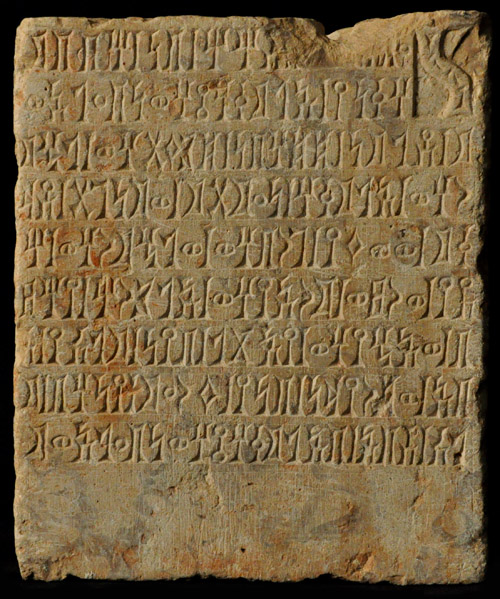
Source: Progetto CASIS (Università di Pisa).
MṢM 115
1 ʿ[.... ʾ](ṣ)ḥḥ bn Ḥbbm
2 hqny ʾlmqh-Ṯhwn-bʿl-ʾw-
3 m ṣlmn ḏ-ḏhbn ḏ-s²ft-hw l-ḫm-
4 r-hw ʾlmqh nʿmtm w-mngt ṣd-
5 qm w-wfy grb-hw w-l-ḫmr-hw ḥ-
6 ẓy w-rḍw mrʾy-hw ʾls²rḥ Yḥḍ-
7 b w-ʾḫy-hw Yʾzl Byn mlky S¹-
8 bʾ w-ḏ-Rydn bny Frʿm Ynhb m-
9 lk S¹bʾ b-ʾlmqh-Ṯhwn-bʿl-ʾwm
1 ʿ[....] ʾṣḥḥ descendant of Ḥbbm
2 dedicated to Almaqah Ṯhwn Master of Awām
3 the bronze statue, which he had promised Him, in order that Almaqah
4 should grant him prosperity and good luck,
5 and the safety of his person; and in order that He should grant him
6 the goodwill and satisfaction of his two lords Ilīsharaḥ Yaḥḍub
7 and his brother Yaʾzil Bayyān, the two kings of Sabaʾ
8 and dhu-Raydān, sons of Farʿam Yanhub, king of
9 Sabaʾ; by ʾAlmaqah Ṯhwn Master of Awām.
Dedicatory inscription in middle Sabaic language from Maʾrib engraved on the base of a statue.
The inscription dates from the middle of the 3rd c. AD.
The graphic style shows letters with thick ends, ḏ with oblique horizontal bars, lozenge-shaped f, wavy r, s² in the shape of Greek sigma.
Monumental script: 4th cent. A.D.

Source: Garbini, Giovanni 1970. Una bilingue sabeo-ebraica da Ẓafar. Annali dell'Istituto Orientale di Napoli, 30/2: 153-165.
Gar Bayt al-Ashwal 2
1 Mlkkrb Yhʾmn w-bny-hw ʾbkrb ʾs¹ʿd w-Ḏrʾʾmr ʾymn ʾm(lk )(S¹)bʾ w-(ḏ-)(R)[ydn w]-
2 Ḥḍrmwt w-Ymnt brʾw w-hwṯrn w-hqwḥ w-hs²qrn byt-hmw Kl[n]-
3 m bn mwṯr-hw ʿdy tfrʿ-hw b-mqm mrʾ-hmw Mrʾ s¹m-
4 yn wrḫ-hw ḏ-Dʾwn ḏ-b-ḫryfn ḏ-l-ṯlṯ w-ts¹ʿy w-ʾrbʿ mʾ[tm]
1 Malkīkarib Yuhanʾim and his sons Abīkarib Asʿad and Dharaʾʾamar Ayman, kings of Sabaʾ, dhu-Raydān,
2 Ḥaḍramawt and Yamanat built, laid foundations, finished and completed their house Klnm,
3 from foundations to top, with the power of their lord, the Lord of heaven.
4 In the month of Dʾwn in the year four hundred ninety-three.
Royal construction inscription in late Sabaic language carved in relief on a stone block from Ẓafār and reused in the nearby village of Bayt al-Ashwāl.
The inscription is dated to 383 AD.
Monumental script: 6th cent. A.D.
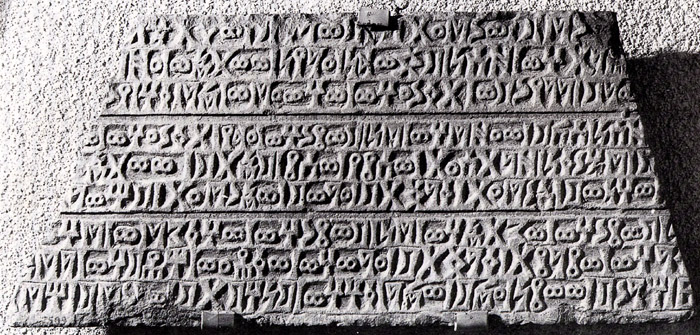
Source: Müller, Walter W. 1991. CIH 325: die jüngste datierte sabäische Inschrift. Pages 118-131 in Études sud-arabes. Recueil offert à Jacques Ryckmans. (Publications de l'Institut Orientaliste de Louvain, 39). Louvain-La-Neuve: Université Catholique de Louvain, Institut Orientaliste.
CIH 325
Inscription in late Sabaic carved in relief on a stone plaque divided into three registers. Unknown origin and preserved in the Archaeological Museum of Istanbul. The inscription, fragmentary on both sides, shows the construction of a structure that remains undetermined. The inscription is dated to 559 AD and is the most recent dated document from South Arabia. The graphic style has ḏ with oblique horizontal bars, r with reverted points, ʾ, b and k decorated with triangular element.
Minuscule script: 11th-end 6th cent. B.C.

Source: Ryckmans, Jacques. 1996. Un abécédaire sud-arabe archaïque complet, gravé sur un pétiole de palme. Pages 11-36 in I primi sessanta anni di scuola. Studi dedicati dagli amici a Sergio Noja Noseda nel suo 65o compleanno, 7 luglio 1996. Lesa: Fondazione Ferni Noja Noseda: 11-36, fig. 1.
Oost. Inst. 37
1 h l ḥ m q w s² r b t s¹ k n ḫ ṣ *s³* f ʾ ʿ ḍ g d ġ ṭ ḏ z y ṯ ẓ #
2 [h] (l) ḥ m (q w s² r b t s¹ k)
Palm-leaf stalk inscribed on the verso with South Arabian abecedary repeated on two lines (only partially on the second line); originating from as-Sawdāʾ and housed in Leiden. Archaic graphic style, classified as (Ry) I, similar to the monumental alphabet, left-to-right s², t repeated instead of the s³.
Minuscule script: 5th-2nd cent. B.C.
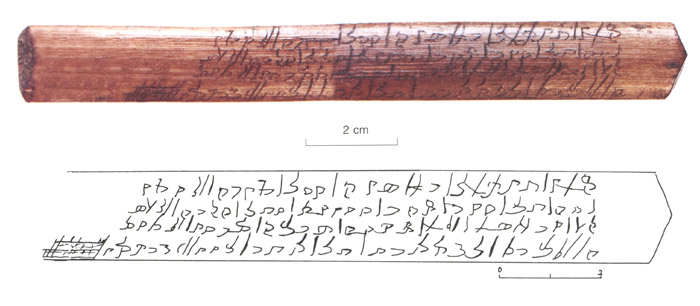
Source: Ryckmans, Jacques, Müller, Walter W. and ʿAbdallāh, Yūsuf M. 1994. Textes du Yémen antique inscrits sur bois (with an English Summary). (Publications de l'Institut orientaliste de Louvain, 43). Louvain: Université Catholique de Louvain, Institut Orientaliste: 62-63, pl. 13/A-B.
YM 11743
1 ṯty blṭtn rḍwym ʿmn Zlgm ḏ-Mzy-
2 dm bn myr ṯmr b-ʿly-k l-bn Mqrm ḏ-hw-
3 qh l-Rḍwt ḏt Ṣ(ḥ)bm wrḫm ʾgby ḏ-Fls¹-
4 m ḏ-ḫrf Ns²ʾkrb bn Kbr Ḫll S²rḥʾl #
1 Two coins of good quality from Zlgm of Mzydm
2 for the delivery of the harvest, which you owe to the family Mqrm, which (in turn) handed it over to
3 Rḍwt of Ṣḥbm in the third decade of the month of dhu-Fls¹m
4 in the year of Ns²ʾkrb of the family Kbr Ḫll. S²rḥʾl (has signed).
Palm-leaf stalk from as-Sawdāʾ and preserved in Ṣanʿāʾ, inscribed on the verso with a contract in Sabaic language.
Graphic style of middle period classified as (Ry) IIIa showing the development of inclined characters.
Minuscule script: 4th-6th cent. A.D.
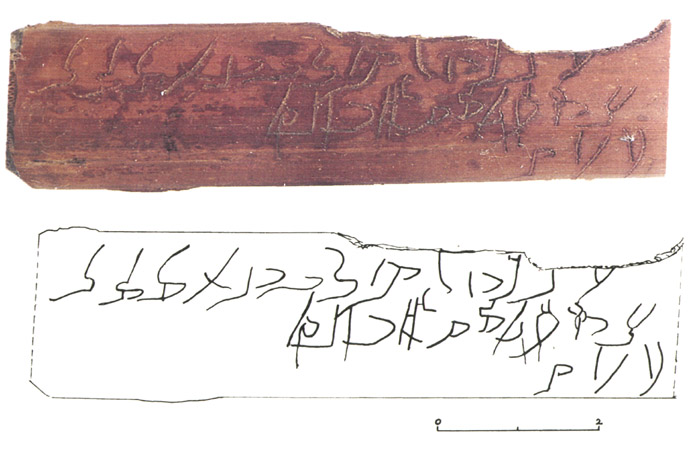
Source: Ryckmans, Jacques, Müller, Walter W. and ʿAbdallāh, Yūsuf M. 1994. Textes du Yémen antique inscrits sur bois (with an English Summary). (Publications de l'Institut orientaliste de Louvain, 43). Louvain: Université Catholique de Louvain, Institut Orientaliste: 43-44, pl. 1/A-B.
YM 11741
1 (h l ḥ) m q w s² r b t s¹ k n
2 ḫ ṣ s³ f ʾ ʿ ḍ g d ġ
3 h h l
Palm-leaf stalk from as-Sawdāʾ and housed in Sanʿāʾ, inscribed on the verso with South Arabian abecedary on the two lines and repeated (only partially) on the third.
Late graphic style, classified as (Ry) IVb, with marked inclination and curvature of the characters, and with emphasis in the horizontal and vertical extension of the letters ends.